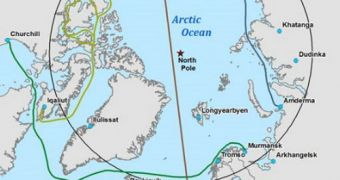It's no longer a secret to anyone that global warming-induced climate change is melting down the Arctic, causing widespread damage to ecosystems and species living at that location. A new analysis indicates that Arctic access routes will also be reshaped considerably over the next four decades.
Land-based routes will most likely dwindle in number, say experts in the United States. With vast amounts of the ice packs gone, there will literally be nothing to travel on. Unlike the Antarctic, the Arctic is not based on solid land, but rather floats directly on the ocean surface.
This led scientists from the University of California in Los Angeles (UCLA) to their next conclusion – sea-based access routes will multiply and diversify over the next decades, in areas where passage was previously impossible.
All of these effects are caused by the massive release of carbon dioxide and other greenhouse gases, mostly from man-made source. These emissions are triggering several feedback loops, whose ultimate effect is the melting of glaciers, the shifting of precipitation patterns, sea level rise and so on.
“As sea ice continues to melt, accessibility by sea will increase, but the viability of an important network of roads that depend on freezing temperatures is threatened by a warming climate,” says the lead author of the new study, UCLA graduate student in geography Scott Stephenson.
The opening of new routes for transport will benefit coastal communities and tourism operators, as well as shipping concerns and coastal resource-extraction operations. But there are also losers in this game.
Inland mining and timber operations, inland oil and gas drilling, and smaller inland communities are expected to be the hardest hit, UCLA researchers say in their new paper. These effects add to those that a melting Arctic will cause on worldwide climate patterns.
“Popular perception holds that climate warming will mean an opening up of the Arctic, but our study shows that this is only partly so. Rising maritime access for ships will be severely countered by falling vehicular access on land,” says Laurence C. Smith.
The expert, a coauthor of the new sutyd, is a UCLA professor of geography and also the author of “The World in 2050: Four Forces Shaping Civilization's Northern Future” (Dutton Books, 2010). Details of the work appear in the June issue of the top journal Nature Climate Change.
Current estimates show that temperatures in the Arctic will increase by anywhere between 3.6 and 6.2 degrees Fahrenheit within the next four decades. During the winter, the increase may reach as much as 7.2 to 10.8 degrees Fahrenheit.
Canada, Finland, Greenland, Iceland, Norway, Russia, Sweden and the United States will all lose important ice roads, that provide land accessibility. The loss could be anywhere between 11 and 82 percent, the UCLA study shows.
“Remote communities that rely on winter roads, especially those that are inland, may have to switch to air cargo services, which will dramatically increase the costs of supplies. That would make life that much harder in these communities,” Stephenson concludes.

 14 DAY TRIAL //
14 DAY TRIAL //